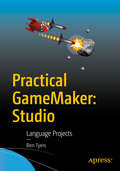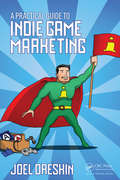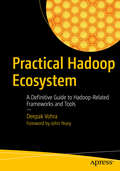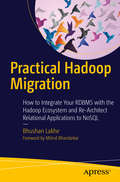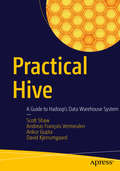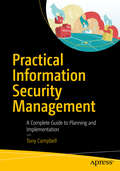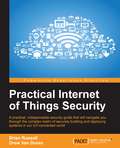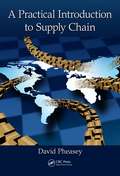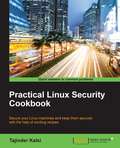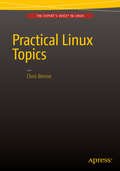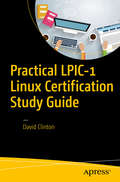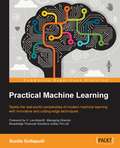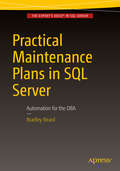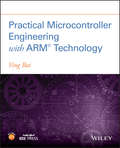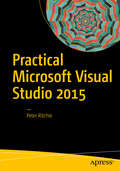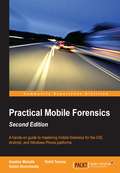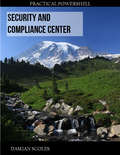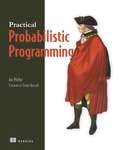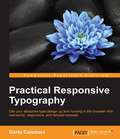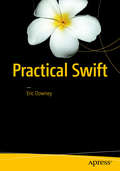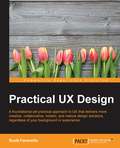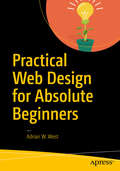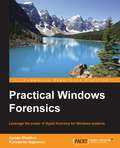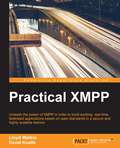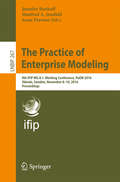- Table View
- List View
Practical GameMaker: Studio
by Ben TyersGain the skills required to create fun and compelling games using GameMaker: Studio, and its GML programming language. In this full-color book you'll learn 24 practical programming elements that are important when creating any game. Each section includes an introduction to a new programming element, some examples, a worksheet, and mini projects to allow you to test your new knowledge. After completing all elements, you will put into action what you have learned in a classic arcade style game. In Practical GameMaker: Studio, you will create a fully featured game, with guidance and in color. After each section you'll see how you'll apply what you've learned to the final game, and discover additional projects to try. These mini projects include a separate scoring guide, and a working example for each, which is useful if you're using this book in an educational environment. Similarly, the book also contains a number of assignments, which you may include as part of any associated coursework in your classes. What You Will Learn Use GameMaker: Studio and GameMaker Language (GML) to create games Work with GML variables, conditionals, drawing, keyport I/O, objects, and events Create GML sprites, health/lives, alarms, collisions, and rooms Improve your game with GML backgrounds, sound and music, splash screens and menus, and effects Include GML random and AI movements in your game Use GML loops, arrays, ds_lists, paths, and scripts Who This Book Is For Experienced game developers new to GameMaker or for those with at least some prior exposure or experience with GameMaker: Studio but who are new to GML.
A Practical Guide to Indie Game Marketing
by Joel DreskinLearn how to market for your indie game, even with a small budget and limited resources. <P><P>For those who want to earn a regular income from making indie games, marketing can be nearly as vital to the success of the game as the game itself. A Practical Guide to Indie Game Marketing provides you with the tools needed to build visibility and sell your game. With special focus on developers with small budgets and limited staff and resources, this book is packed with recommendations and techniques that you can put to use immediately. As a seasoned marketing professional, author Joel Dreskin provides insight into practical, real-world experiences from marketing numerous successful games and also shares tips on mistakes to avoid. Presented in an easy to read format, A Practical Guide to Indie Game Marketing includes information on establishing an audience and increasing visibility so you can build successes with your studio and games. <P><P>Through case studies, examples, guidelines and tips, you will learn best practices for developing plans for your game launches, PR, community engagement, channel promotions and more <P><P>Sample timelines help you determine how long in advance of a launch to prepare your first public communications, when to announce your game, as well as recommended timing for releasing different game assets <P><P>Book also includes marketing checklist 'cheat sheets', dos and don’ts and additional resources
Practical Hadoop Ecosystem
by Deepak VohraLearn how to use the Apache Hadoop projects, including MapReduce, HDFS, Apache Hive, Apache HBase, Apache Kafka, Apache Mahout, and Apache Solr. From setting up the environment to running sample applications each chapter in this book is a practical tutorial on using an Apache Hadoop ecosystem project. While several books on Apache Hadoop are available, most are based on the main projects, MapReduce and HDFS, and none discusses the other Apache Hadoop ecosystem projects and how they all work together as a cohesive big data development platform. What You Will Learn: Set up the environment in Linux for Hadoop projects using Cloudera Hadoop Distribution CDH 5 Run a MapReduce job Store data with Apache Hive, and Apache HBase Index data in HDFS with Apache Solr Develop a Kafka messaging system Develop a Mahout User Recommender System Stream Logs to HDFS with Apache Flume Transfer data from MySQL database to Hive, HDFS, and HBase with Sqoop Create a Hive table over Apache Solr Who This Book Is For: Apache Hadoop developers. Pre-requisite knowledge of Linux and some knowledge of Hadoop is required.
Practical Hadoop Migration
by Bhushan LakhePractical Hadoop Migration shows database developers, database administrators, enterprise architects, and IT leaders how to re-architect relational applications to NoSQL, integrate relational database management systems with the Hadoop ecosystem, and transform and migrate relational data to and from Hadoop components. Winner of IBM's 2012 Gerstner Award for his implementation of big data and data warehouse initiatives and author of Practical Hadoop Security, author Bhushan Lakhe walks you through the entire transition process. First, he lays out the criteria for deciding what blend of re-architecting, migration, and integration between RDBMS and HDFS best meets your transition objectives. Then he demonstrates how to design your transition model. He covers the best-practice design approaches to re-architecting your relational applications and transforming your relational data to optimize concurrency, security, denormalization, and performance in their NoSQL targets. Lakhe proceeds to cover the selection criteria for ETL tools, the implementation steps for migration with SQOOP- and Flume-based data transfers, and transition optimization techniques for tuning partitions, scheduling aggregations, and redesigning ETL. Finally, he assesses the pros and cons of data lakes and Lambda architecture as integrative solutions and illustrates their implementation with real-world case studies. Hadoop/NoSQL solutions do not offer by default cer tain relational technology features such as role-based access control, locking for concurrent updates, and various tools for measuring and enhancing performance. Practical Hadoop Migration shows how to use open-source tools to emulate such relational functionalities in Hadoop ecosystem components.
Practical Hive
by Scott Shaw Andreas François Vermeulen Ankur Gupta David KjerrumgaardDive into the world of SQL on Hadoop and get the most out of your Hive data warehouses. This book is your go-to resource for using Hive: authors Scott Shaw, Ankur Gupta, David Kjerrumgaard, and Andreas Francois Vermeulen take you through learning HiveQL, the SQL-like language specific to Hive, to analyze, export, and massage the data stored across your Hadoop environment. From deploying Hive on your hardware or virtual machine and setting up its initial configuration to learning how Hive interacts with Hadoop, MapReduce, Tez and other big data technologies, Practical Hive gives you a detailed treatment of the software. In addition, this book discusses the value of open source software, Hive performance tuning, and how to leverage semi-structured and unstructured data. What You Will Learn Install and configure Hive for new and existing datasets Perform DDL operations Execute efficient DML operations Use tables, partitions, buckets, and user-defined functions Discover performance tuning tips and Hive best practices Who This Book Is For Developers, companies, and professionals who deal with large amounts of data and could use software that can efficiently manage large volumes of input. It is assumed that readers have the ability to work with SQL.
Practical Information Security Management
by Tony CampbellCreate appropriate, security-focused business propositions that consider the balance between cost, risk, and usability, while starting your journey to become an information security manager. Covering a wealth of information that explains exactly how the industry works today, this book focuses on how you can set up an effective information security practice, hire the right people, and strike the best balance between security controls, costs, and risks. Practical Information Security Management provides a wealth of practical advice for anyone responsible for information security management in the workplace, focusing on the 'how' rather than the 'what'. Together we'll cut through the policies, regulations, and standards to expose the real inner workings of what makes a security management program effective, covering the full gamut of subject matter pertaining to security management: organizational structures, security architectures, technical controls, governance frameworks, and operational security. This book was not written to help you pass your CISSP, CISM, or CISMP or become a PCI-DSS auditor. It won't help you build an ISO 27001 or COBIT-compliant security management system, and it won't help you become an ethical hacker or digital forensics investigator - there are many excellent books on the market that cover these subjects in detail. Instead, this is a practical book that offers years of real-world experience in helping you focus on the getting the job done. What You Will Learn Learn the practical aspects of being an effective information security manager Strike the right balance between cost and risk Take security policies and standards and make them work in reality Leverage complex security functions, such as Digital Forensics, Incident Response and Security Architecture Who This Book Is For Anyone who wants to make a difference in offering effective security management for their business. You might already be a security manager seeking insight into areas of the job that you've not looked at before, or you might be a techie or risk guy wanting to switch into this challenging new career. Whatever your career goals are, Practical Security Management has something to offer you.
Practical Internet of Things Security
by Drew Van Duren Brian RussellA practical, indispensable security guide that will navigate you through the complex realm of securely building and deploying systems in our IoT-connected world About This Book * Learn to design and implement cyber security strategies for your organization * Learn to protect cyber-physical systems and utilize forensic data analysis to beat vulnerabilities in your IoT ecosystem * Learn best practices to secure your data from device to the cloud * Gain insight into privacy-enhancing techniques and technologies Who This Book Is For This book targets IT Security Professionals and Security Engineers (including pentesters, security architects and ethical hackers) who would like to ensure security of their organization's data when connected through the IoT. Business analysts and managers will also find it useful. What You Will Learn * Learn how to break down cross-industry barriers by adopting the best practices for IoT deployments * Build a rock-solid security program for IoT that is cost-effective and easy to maintain * Demystify complex topics such as cryptography, privacy, and penetration testing to improve your security posture * See how the selection of individual components can affect the security posture of the entire system * Use Systems Security Engineering and Privacy-by-design principles to design a secure IoT ecosystem * Get to know how to leverage the burdgening cloud-based systems that will support the IoT into the future. In Detail With the advent of Intenret of Things (IoT), businesses will be faced with defending against new types of threats. The business ecosystem now includes cloud computing infrastructure, mobile and fixed endpoints that open up new attack surfaces, a desire to share information with many stakeholders and a need to take action quickly based on large quantities of collected data. . It therefore becomes critical to ensure that cyber security threats are contained to a minimum when implementing new IoT services and solutions. . The interconnectivity of people, devices, and companies raises stakes to a new level as computing and action become even more mobile, everything becomes connected to the cloud, and infrastructure is strained to securely manage the billions of devices that will connect us all to the IoT. This book shows you how to implement cyber-security solutions, IoT design best practices and risk mitigation methodologies to address device and infrastructure threats to IoT solutions. This book will take readers on a journey that begins with understanding the IoT and how it can be applied in various industries, goes on to describe the security challenges associated with the IoT, and then provides a set of guidelines to architect and deploy a secure IoT in your Enterprise. The book will showcase how the IoT is implemented in early-adopting industries and describe how lessons can be learned and shared across diverse industries to support a secure IoT. Style and approach This book aims to educate readers on key areas in IoT security. It walks readers through engaging with security challenges and then provides answers on how to successfully manage IoT security and build a safe infrastructure for smart devices. After reading this book, you will understand the true potential of tools and solutions in order to build real-time security intelligence on IoT networks.
A Practical Introduction to Supply Chain
by David PheaseyIn many businesses, supply chain people are trapped in reactive roles where they source, contract, purchase, receive, warehouse, and ship as a service. However, in some businesses suppliers contribute to improvement programs, technology, funding, marketing, logistics, and engineering expertise. Breaking into a proactive supply chain role takes broad thinking, a talent for persuasion, and the courage to go after it. This book supplies proven methods to help you do so.A Practical Introduction to Supply Chain describes how to run an efficient supply chain that exceeds expectations in terms of cost, quality, and supplier delivery. It explains the need to integrate systems, the flow of information, and the way in which people work together between commercial purchasing, materials management, and distribution parts of the supply chain.Sharing powerful insights from the perspective of a supply chain manager, the book details practical techniques drawn from the author’s decades of experience. It presents methods that apply directly to supply chains involving a physical product, manufactured internally or outsourced, as well as physical operations such as oilfield services.This book demonstrates how to make a supply chain organization work in practice—contributing more to business success than traditional purchasing and logistics organizations can. In addition to writing about practical supply chain issues and approaches, the author also describes proven methods he used while working with client teams on assignments. He also details some of the ways his teams used to manage the people part of the change.
Practical Linux Security Cookbook
by Tajinder KalsiSecure your Linux machines and keep them secured with the help of exciting recipes About This Book * This book provides code-intensive discussions with detailed recipes that help you understand better and learn faster. * More than 50 hands-on recipes to create and administer a secure Linux system locally as well as on a network * Enhance file system security and local and remote user authentication by using various security tools and different versions of Linux for different tasks Who This Book Is For Practical Linux Security Cookbook is intended for all those Linux users who already have knowledge of Linux File systems and administration. You should be familiar with basic Linux commands. Understanding Information security and its risks to a Linux system is also helpful in understanding the recipes more easily. However, even if you are unfamiliar with Information security, you will be able to easily follow and understand the recipes discussed. Since Linux Security Cookbook follows a practical approach, following the steps is very easy. What You Will Learn * Learn about various vulnerabilities and exploits in relation to Linux systems * Configure and build a secure kernel and test it * Learn about file permissions and security and how to securely modify files * Explore various ways to authenticate local users while monitoring their activities. * Authenticate users remotely and securely copy files on remote systems * Review various network security methods including firewalls using iptables and TCP Wrapper * Explore various security tools including Port Sentry, Squid Proxy, Shorewall, and many more * Understand Bash vulnerability/security and patch management In Detail With the growing popularity of Linux, more and more administrators have started moving to the system to create networks or servers for any task. This also makes Linux the first choice for any attacker now. Due to the lack of information about security-related attacks, administrators now face issues in dealing with these attackers as quickly as possible. Learning about the different types of Linux security will help create a more secure Linux system. Whether you are new to Linux administration or experienced, this book will provide you with the skills to make systems more secure. With lots of step-by-step recipes, the book starts by introducing you to various threats to Linux systems. You then get to walk through customizing the Linux kernel and securing local files. Next you will move on to manage user authentication locally and remotely and also mitigate network attacks. Finally, you will learn to patch bash vulnerability and monitor system logs for security. With several screenshots in each example, the book will supply a great learning experience and help you create more secure Linux systems. Style and approach An easy-to-follow cookbook with step-by-step practical recipes covering the various Linux security administration tasks. Each recipe has screenshots, wherever needed, to make understanding more easy.
Practical Linux Topics
by Chris BinnieTeaches you how to improve your hands-on knowledge of Linux using challenging, real-world scenarios. Each chapter explores a topic that has been chosen specifically to demonstrate how to enhance your base Linux system, and resolve important issues. This book enables sysadmins, DevOps engineers, developers, and other technical professionals to make full use of Linux's rocksteady foundation. Explore specific topics in networking, email, filesystems, encryption, system monitoring, security, servers, and more-- including systemd and GPG. Understand salient security concerns and how to mitigate them. Applicable to almost all Linux flavors--Debian, Red Hat, Ubuntu, Linux Mint, CentOS--Practical Linux Topics �__c�__an be used to reference other Unix-type systems with little modification. Improve your practical know-how and background knowledge on servers and workstations alike, increase your ability to troubleshoot and ultimately solve the daily challenges encountered by all professional Linux users. Empower your Linux skills by adding Practical Linux Topics to your library today. What you'll learn Solve a variety of challenges faced by sysadmins and DevOps engineers Understand the security implications of the actions you take Study the history behind some of the packages that you are using for a greater in-depth understanding Become a professional at troubleshooting Extend your knowledge by learning about multiple OSs and third-party packages Who this book is for Having mastered the basics of running Linux systems this book takes you one step further to help you master the elements of Linux which you may have struggled with in the past. You have progressed past the basic stages of using Linux and want to delve into the more complex aspects. Practical Linux instantly offers answers to problematic scenarios and provides invaluable information for future reference. It is an invaluable addition to any Linux library. Table of Contents Chapter 1: Real-time Network Monitoring from the Console Chapter 2: Destroying Sensitive Data Chapter 3: Supercharged systemd Chapter 4: Zero Downtime Linux Chapter 5: Get More with wget Chapter 6: Securing SSH withPAM Chapter 7: Your Discs, Your Way Chapter 8: No SFTP Doesn't Mean No Encryption Chapter 9: Making the Most of the Screen Utility Chapter 10: Improve Your Security with SELinux Chapter 11: Nattier Networks Chapter 12: Keeping information Private with GPG Chapter 13: Get Permission From Your Peers with Sudo Chapter 14: Loop Disks and Wubi Appendix A: Hack, Break, and Fix Your Servers
Practical LPIC-1 Linux Certification Study Guide
by David ClintonThis book is your complete guide to studying for the Linux Professional Institute's Server Professional (LPIC-1) certification. Every concept, principle, process, and resource that might make an appearance on the exam is fully represented. You will understand every concept by rolling up your sleeves, opening up a terminal, and trying it all yourself. You will find suggestions for practical tasks along with "test-yourself" quizzes at the end of each chapter. Whether you've decided to earn the Linux Professional Institute's Server Professional certification or you simply want to learn more about Linux administration, this book is a great choice. Right now, Linux administration skills are opening doors to some of the hottest job markets. And with the ongoing explosive growth of the cloud computing world - the vast majority of which is being built with Linux - the scope of the opportunities will only increase. Whether or not you end up taking the exam, if you manage to learn this material, you'll have done yourself a real favor. What You Will Learn Basic Linux system administration and package management Device and desktop management Bash scripting Networking fundamentals Security administration Who This Book Is For Most potential readers will already have a decent idea of what Linux is and what kinds of things can be done with it, and are looking to acquire or formalize a more structured and complete ability to confidently administrate Linux systems.
Practical Machine Learning
by Sunila GollapudiThis book has been created for data scientists who want to see machine learning in action and explore its real-world application. With guidance on everything from the fundamentals of machine learning and predictive analytics to the latest innovations set to lead the big data revolution into the future, this is an unmissable resource for anyone dedicated to tackling current big data challenges. Some knowledge of Java programming and any scripting language is advisable if you want to get started immediately.
Practical Maintenance Plans in SQL Server
by Bradley BeardThis book is a complete guide to setting up and maintaining maintenance plans for SQL Server Database Administrators. Maintenance plans too often consist of a backup task and that's it, but there is so much more that can and must be done to ensure the integrity of your most important company resource - the data you are tasked to manage and safeguard. This book walks even the newest of users through creating a powerful, automated maintenance plan. Automate your job using SQL Server Agent to leverage the power of Maintenance Plans to deliver real, proactive solutions to common issues. Schedule common tasks such as backups and index rebuilds to run automatically, and get early-warning notifications of impending problems relating to resource usage and query performance. By the time your boss knows to call you about a problem, you'll have already called him to describe your solution. The large majority of books never really cover the topic of inheriting a database server with multiple live databases; the common thread is that the databases will be created and maintained by the reader forever and ever. In the real world, that scenario rarely happens. Practical Maintenance Plans in SQL Server covers that scenario and provides you with the knowledge and tools needed to get comfortable writing your own maintenance plans for any SQL Server database, whether created by you or inherited. Shows the different tasks that can be run in a maintenance plan. Explains how and why those tasks can be implemented. Provides a roadmap to creating your own custom maintenance plan. What you'll learn Implement a completely automated backup maintenance plan Be alerted to performance problems and outages ahead of your boss Learn the different types of database maintenance tasks Plan the workflow of tasks within a maintenance plan Automate your work by implementing custom maintenance plans Who this book is for Practical Maintenance Plans in SQL Server is for any level of database administrator, but specifically it's for those administrators with a real need to set up a powerful maintenance plan quickly. New and seasoned administrators will appreciate the book for its robust learning pattern of visual aids in combination with explanations and scenarios. Practical Maintenance Plans in SQL Server is the perfect "new hire" gift for new database administrators in any organization.
Practical Microcontroller Engineering with ARM Technology
by Ying BaiThis book covers both the fundamentals, as well as practical techniques in designing and building microcontrollers in industrial and commercial applications. Examples included in this book have been compiled, built, and tested Includes Both ARM® assembly and C codes Direct Register Access (DRA) model and the Software Driver (SD) model programming techniques and discussed If you are an instructor and adopted this book for your course, please email ieeeproposals@wiley. com to get access to the instructor files for this book.
Practical Microsoft Visual Studio 2015
by Peter RitchieLearn the details of the most highly recommended practices of software development using the latest version of Visual Studio 2015. Recommended practices are grouped by development phase and explained in far more detail than the typical tips and tricks compilations. This book also contains detailed coverage of recognized patterns and practices used to create software in a timely manner with expected quality in the context of using specific Visual Studio 2015 features. Creating software is part defined process and part empirical process. While there is no single "best" process to employ in all development scenarios, MVP author Peter Ritchie helps readers navigate the complexity of development options and decide which techniques and Visual Studio 2015 features to use based on the needs of their particular project. Readers will learn practices such as those related to working in teams, design and architecture, refactoring, source code control workflows, unit testing, performance testing, coding practices, use of common patterns, code analysis, IDE extensions, and more. What You Will Learn Use patterns and practices within Visual Studio Implement practices of software creation Work in teams Develop workflows for software projects Who This Book Is For Beginning and intermediate software developers and architects
Practical Mobile Forensics - Second Edition
by Satish Bommisetty Heather Mahalik Rohit TammaA hands-on guide to mastering mobile forensics for the iOS, Android, and the Windows Phone platforms About This Book * Get to grips with the basics of mobile forensics and the various forensic approaches * Retrieve and analyze the data stored on mobile devices and on the cloud * A practical guide to leverage the power of mobile forensics on the popular mobile platforms with lots of tips, tricks and caveats Who This Book Is For This book is for forensics professionals who are eager to widen their forensics skillset to mobile forensics and acquire data from mobile devices. What You Will Learn * Discover the new features in practical mobile forensics * Understand the architecture and security mechanisms present in iOS and Android platforms * Identify sensitive files on the iOS and Android platforms * Set up the forensic environment * Extract data on the iOS and Android platforms * Recover data on the iOS and Android platforms * Understand the forensics of Windows devices * Explore various third-party application techniques and data recovery techniques In Detail Mobile phone forensics is the science of retrieving data from a mobile phone under forensically sound conditions. This book is an update to Practical Mobile Forensics and it delves into the concepts of mobile forensics and its importance in today's world. We will deep dive into mobile forensics techniques in iOS 8 - 9.2, Android 4.4 - 6, and Windows Phone devices. We will demonstrate the latest open source and commercial mobile forensics tools, enabling you to analyze and retrieve data effectively. You will learn how to introspect and retrieve data from cloud, and document and prepare reports for your investigations. By the end of this book, you will have mastered the current operating systems and techniques so you can recover data from mobile devices by leveraging open source solutions. Style and approach This book takes a very practical approach and depicts real-life mobile forensics scenarios with lots of tips and tricks to help acquire the required forensics skillset for various mobile platforms.
Practical PowerShell Security and Compliance Center: Get to grips with effectively managing the Security and Compliance Center with PowerShell, 2nd Edition
by Damian ScolesLearn all the latest practices to build and enhance your PowerShell scripts and manage the Security and Compliance Center easily and efficiently Key Features Gather the latest information and new cmdlets to get started with PowerShell Discover innovative ways to construct useful scripts Learn how to manage SCC with PowerShell through real-world scenarios Book Description PowerShell is an integral part of Office 365. This updated edition shares tips, tricks, new cmdlets, and best practices for using PowerShell with the Security and Compliance Center. The book starts by covering the basic tools of PowerShell, such as PowerShell ISE and PowerShell repositories, and then goes on to teach you how to connect to the SCC using multi-factor authentication. You will manage role groups to layer security, before exploring the importance of information barriers. As you progress, you will orchestrate insider risk policies to protect your organization from malicious users with access to sensitive data. Next, the book will show you how to manage various devices using tenant policies and device access rules. Later chapters will delve into various reporting methods and explore options for troubleshooting scripts and best practices to produce better scripts. The book concludes with an overview of Microsoft Secure Score to help you measure your organization's security posture. By the end of this book, you'll have the latest information and new cmdlets to confidently manage the Security and Compliance Center (SCC) with PowerShell. What you will learn Enhance the script, test it, and move it into production Make your PowerShell scripts more usable and accessible Study directory synchronization and its applications Explore layers of security that prevent unauthorized access Use PowerShell to implement Data Loss Prevention (DLP) Understand compliance and how it can be managed with PowerShell Who this book is for If you are already managing Exchange and have some PowerShell experience, then this book is for you. Professionals who want to gain more proficiency in PowerShell but are unsure of how to approach it will also find this book useful. To get the most out of this book, you must have sufficient experience of working in PowerShell as the book is not a beginner's guide to PowerShell.
Practical Probabilistic Programming
by Avi PfefferSummaryPractical Probabilistic Programming introduces the working programmer to probabilistic programming. In it, you'll learn how to use the PP paradigm to model application domains and then express those probabilistic models in code. Although PP can seem abstract, in this book you'll immediately work on practical examples, like using the Figaro language to build a spam filter and applying Bayesian and Markov networks, to diagnose computer system data problems and recover digital images. Purchase of the print book includes a free eBook in PDF, Kindle, and ePub formats from Manning Publications.About the TechnologyThe data you accumulate about your customers, products, and website users can help you not only to interpret your past, it can also help you predict your future! Probabilistic programming uses code to draw probabilistic inferences from data. By applying specialized algorithms, your programs assign degrees of probability to conclusions. This means you can forecast future events like sales trends, computer system failures, experimental outcomes, and many other critical concerns. About the BookPractical Probabilistic Programming introduces the working programmer to probabilistic programming. In this book, you’ll immediately work on practical examples like building a spam filter, diagnosing computer system data problems, and recovering digital images. You’ll discover probabilistic inference, where algorithms help make extended predictions about issues like social media usage. Along the way, you’ll learn to use functional-style programming for text analysis, object-oriented models to predict social phenomena like the spread of tweets, and open universe models to gauge real-life social media usage. The book also has chapters on how probabilistic models can help in decision making and modeling of dynamic systems. What's InsideIntroduction to probabilistic modelingWriting probabilistic programs in FigaroBuilding Bayesian networksPredicting product lifecyclesDecision-making algorithmsAbout the ReaderThis book assumes no prior exposure to probabilistic programming. Knowledge of Scala is helpful. About the AuthorAvi Pfeffer is the principal developer of the Figaro language for probabilistic programming. Table of ContentsPART 1 INTRODUCING PROBABILISTIC PROGRAMMING AND FIGAROProbabilistic programming in a nutshell A quick Figaro tutorial Creating a probabilistic programming application PART 2 WRITING PROBABILISTIC PROGRAMSProbabilistic models and probabilistic programs Modeling dependencies with Bayesian and Markov networks Using Scala and Figaro collections to build up models Object-oriented probabilistic modeling Modeling dynamic systems PART 3 INFERENCEThe three rules of probabilistic inference Factored inference algorithms Sampling algorithms Solving other inference tasks Dynamic reasoning and parameter learning
Practical Responsive Typography
by Dario CalonaciGet your attractive type design up and running in the browser with real-world, responsive, and tailored tutorials About This Book * No coding experience necessary - get started with responsive typography today! * Find out how to customize your own typography designs to truly own your website's identity * From the basics to cutting-edge design, this book is the perfect guide Who This Book Is For This book is for web developers familiar with the basics of HTML5 and CSS3 who want to learn how to implement responsive typography. No coding experience is required, so dive in and get started! What You Will Learn * Customize and personalize fonts on a responsive website * Learn how to write CSS3 rules for viewports * Define media queries and write them using CSS3 and HTML5 * Implement SASS typography techniques to minimize the CSS output and manage the font variables * Get to grips with dropcaps and learn how to use them effectively on the web In Detail Typography is an essential part of any website's design. It can help you stand out from the crowd, communicate with clarity, and cultivate a distinctive identity. Practical Responsive Typography demonstrates how to use typography to greatest effect. With this book you won't underestimate it's importance - you'll be in complete control over this crucial component of web design. From scaling and optimizing screen spaces to using a range of different web fonts, you'll quickly get up to speed with the practical considerations behind successful typography. But more than the fundamentals, you'll also find out how to go further by customizing typography designs to suit your identity. Style and approach This is an easy-to-follow guide full of real-world examples and tutorials. Each typography style and rule is clearly explained and placed in context.
Practical Swift
by Eric DowneyTake a firsthand tour of Xcode and all the latest features Swift 3 has to offer. If you have picked up this book, chances are you know a little bit about Swift Programming. With Practical Swift you'll develop an advanced understanding of the language that will enable you to create a reference guide using Xcode Playgrounds, one you can continue to grow throughout your iOS career. This book not only shows you how to code in a clean and concise manner, but also the why behind the code. Understanding why will be instrumental in your advancement as a Swift developer. What You'll learn: Review the evolution of Swift and the latest features in Swift 3 Study architecture and design patterns Examine Protocol Oriented Programming Understand Swift generics Test Swift code Build an iOS App with core data from scratch Who This Book Is For: The primary audience for this book is developers who have started learning iOS and Swift and want to learn more of the intermediate to advanced topics available in Swift. The secondary audience is developers who have experience in iOS and Swift and want a good reference book for concepts they might already know, but are looking to re-enforce.
Practical UX Design
by Scott FaranelloA foundational yet practical approach to UX that delivers more creative, collaborative, holistic, and mature design solutions, regardless of your background or experience About This Book * Improve your UX design awareness and skills * Gain greater confidence to know when you have delivered a "good" UX design * Learn by example using a book designed by a UX mind for a UX mind Who This Book Is For This book is written for the beginner as well as the experienced UX practitioner, regardless of team size, company size, or job title. It is also intended for anyone with an interest in UX, engages with UX, is involved in any way in interactive problem solving and design, or simply wants to learn more about what we do, how we do it, and why those in the UX field are so passionate about wanting to do it better. What You Will Learn * Awaken your UX mind and dispel the myths of non-UX thinkers * Create the six optimal conditions for your best ideas to appear * Identify and incorporate the ten design principles found in all good UX design * Develop a broader understanding of Information Architecture (IA) to better engage, guide, and inform * Develop a fundamental understanding of patterns and the properties that create them * Raise your level of UX maturity with a strategy that transforms your approach to problem solving and helps others understand the true value of your work * Utilize important tools of the UX trade that never go out of style * Increase your knowledge of UX, incorporate valuable ideas and insights into your work, and look at design from a very unique perspective In Detail Written in an easy-to-read style, this book provides real-world examples, a historical perspective, and a holistic approach to design that will ground you in the fundamental essentials of interactive design, allow you to make more informed design decisions, and increase your understanding of UX in order to reach the highest levels of UX maturity. As you will see, UX is more than just delighting customers and users. It is also about thinking like a UX practitioner, making time for creativity, recognizing good design when you see it, understanding Information Architecture as more than just organizing and labeling websites, using design patterns to influence user behavior and decision making, approaching UX from a business perspective, transforming your client's and company's fundamental understanding of UX and its true value, and so much more. This book is an invaluable resource of knowledge, perspective, and inspiration for those seeking to become better UX designers, increase their confidence, become more mature design leaders, and deliver solutions that provide measurable value to stakeholders, customers, and users regardless of project type, size, and delivery method. Style and approach An in-depth, easy to read, and entertaining journey into and through the world of UX using real-world examples, thoughtful illustrations, and engaging quotes to inspire and explain fully the how and why of UX in a practical and impactful way and used immediately in your own work.
Practical Web Design for Absolute Beginners
by Adrian W. WestLearn the fundamentals of modern web design, rather than relying on CMS programs, such as WordPress or Joomla!. You will be introduced to the essentials of good design and how to optimize for search engines. You will discover how to register a domain name and migrate a website to a remote host. Because you will have built the web pages yourself, you will know exactly how HTML and CSS work. You have will complete control over your websites and their maintenance. Practical Website Design for Absolute Beginners centers around introducing small amounts of new code in short practical chapters and provides many website templates that can be easily adapted for your own websites. Each chapter builds on the templates created in the previous chapter. You are provided with a practical project to complete in most chapters, and taught to produce practical web pages right from the start. In the first chapter you will install and configure a free text editor, then you will produce the structure for your first web page. You will then gradually learn to create more sophisticated and increasingly practical web pages and websites. In this book you will be encouraged by means of a series of achievable goals, and you will be rewarded by the knowledge that you are learning something valuable and really worthwhile. You will not have to plow through daunting chapters of disembodied code theory because the code is described and explained in context within each project. Because each project is fully illustrated, you will see clearly what you are expected to achieve as you create each web page. What You'll Learn Provides instructions for installing a text editor for producing HTML and CSS Shows you step-by-step how to build and test web pages and websites Teaches you how to ensure that your websites are attractive and useful Describes how to make the most effective use of color and images Teaches you the essential features of search engine optimization Shows you how to migrate your website to a remote host Who This Book Is For Practical Website Design for Absolute Beginners is for people who want to begin designing their own websites. It uses a highly motivational, easily assimilated step-by-step approach where you will start learning practical skills from the very first chapter. The book is an excellent choice for people who have computer skills but would also like to learn HTML and CSS. For readers who have little or no knowledge of HTML and CSS, the book will teach enough to complete all the projects in the book.
Practical Windows Forensics
by Konstantin Sapronov Ayman ShaabanLeverage the power of digital forensics for Windows systems About This Book * Build your own lab environment to analyze forensic data and practice techniques. * This book offers meticulous coverage with an example-driven approach and helps you build the key skills of performing forensics on Windows-based systems using digital artifacts. * It uses specific open source and Linux-based tools so you can become proficient at analyzing forensic data and upgrade your existing knowledge. Who This Book Is For This book targets forensic analysts and professionals who would like to develop skills in digital forensic analysis for the Windows platform. You will acquire proficiency, knowledge, and core skills to undertake forensic analysis of digital data. Prior experience of information security and forensic analysis would be helpful. You will gain knowledge and an understanding of performing forensic analysis with tools especially built for the Windows platform. What You Will Learn * Perform live analysis on victim or suspect Windows systems locally or remotely * Understand the different natures and acquisition techniques of volatile and non-volatile data. * Create a timeline of all the system actions to restore the history of an incident. * Recover and analyze data from FAT and NTFS file systems. * Make use of various tools to perform registry analysis. * Track a system user's browser and e-mail activities to prove or refute some hypotheses. * Get to know how to dump and analyze computer memory. In Detail Over the last few years, the wave of the cybercrime has risen rapidly. We have witnessed many major attacks on the governmental, military, financial, and media sectors. Tracking all these attacks and crimes requires a deep understanding of operating system operations, how to extract evident data from digital evidence, and the best usage of the digital forensic tools and techniques. Regardless of your level of experience in the field of information security in general, this book will fully introduce you to digital forensics. It will provide you with the knowledge needed to assemble different types of evidence effectively, and walk you through the various stages of the analysis process. We start by discussing the principles of the digital forensics process and move on to show you the approaches that are used to conduct analysis. We will then study various tools to perform live analysis, and go through different techniques to analyze volatile and non-volatile data. Style and approach This is a step-by-step guide that delivers knowledge about different Windows artifacts. Each topic is explained sequentially, including artifact analysis using different tools and techniques. These techniques make use of the evidence extracted from infected machines, and are accompanied by real-life examples.
Practical XMPP
by David Koelle Lloyd WatkinUnleash the power of XMPP in order to build exciting, real-time, federated applications based on open standards in a secure and highly scalable fashion About This Book * Learn about the fundamentals of XMPP and be able to work with the core functionality both server-side and in the browser * Build a simple 1-to-1 chat (the "Hello World" of XMPP), explore multi-user chat, publish subscribe systems, and work with a decentralized social network * Author Lloyd Watkins is a member of the XMPP standards committee Who This Book Is For If you want to learn about the fundamentals of XMPP, be able to work with the core functionality both server-side and in the browser then this book is for you.No knowledge of XMPP is required, or of TCP/IP networking. It's important that you already know how to build applications of some form, and are looking get a better understanding of how to implement XMPP for one or more of its many uses. You should be interested in the decentralized web, know HTML, and likely know JavaScript and NodeJS. You will probably know JSON, and hopefully XML (this is the native output of XMPP). What You Will Learn * Install and configure an XMPP server and use it to connect from a traditional desktop client and send a message * Build a simple server-side application that will respond to messages from our logged in desktop client * Install and run XMPP-FTW, connect to the server from the browser, and handle incoming/outgoing messages * Connect to a multi-user chat room, send/receive stanzas, add a room password, join a protected room, set the room's subject, and change a user's affiliation * Get to grips with the publish-subscribe extension of XMPP and use it to build a pusher system that can make any website real-time * Build a simple XMPP component and create an extension for XMPP-FTW that allows you to use your own custom format * Build an XMPP version of the classic game "Pong" In Detail XMPP (eXtensible Messaging and Presence Protocol) is a messaging protocol that enables communication between two or more devices via the Internet. With this book, developers will learn about the fundamentals of XMPP, be able to work with the core functionality both server-side and in the browser, as well as starting to explore several of the protocol extensions. You will not only have a solid grasp of XMPP and how it works, but will also be able to use the protocol to build real-world applications that utilize the power of XMPP. By the end of this book, you will know more about networking applications in general, and have a good understanding of how to extend XMPP, as well as using it in sample applications. Style and approach Through a number of hands-on projects, this book shows you how to build usable applications that highlights a feature of XMPP.
The Practice of Enterprise Modeling: 9th IFIP WG 8.1. Working Conference, PoEM 2016, Skövde, Sweden, November 8-10, 2016, Proceedings (Lecture Notes in Business Information Processing #267)
by Jennifer Horkoff, Manfred A. Jeusfeld and Anne PerssonThis volume constitutes the proceedings of the 9th IFIP WG 8.1 Conference on the Practice of Enterprise Modeling held in November 2016 in Skövde, Sweden. The PoEM conference series started in 2008 and aims to provide a forum sharing knowledge and experiences between the academic community and practitioners from industry and the public sector. The 18 full papers and 9 short papers accepted were carefully reviewed and selected from 54 submissions and cover topics related to information systems development, enterprise modeling, requirements engineering, and process management. In addition, the keynote by Robert Winter on “Establishing 'Architectural Thinking' in Organizations” is also included in this volume.
